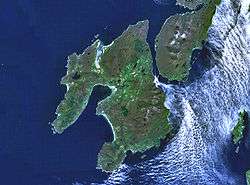Islay whisky
Islay whisky is Scotch whisky made on Islay (/ˈaɪlə/ EYE-lə) or Ìle in Gaelic, one of the southernmost of the Inner Hebridean Islands located off the west coast of Scotland. Islay is one of five whisky distilling localities and regions in Scotland whose identity is protected by law.[1]
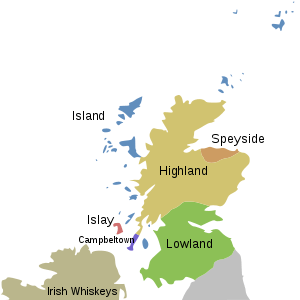
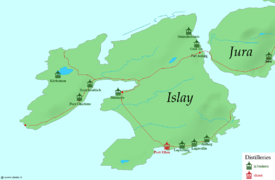
The region is characterised by whiskies with a peat smoke aroma, such as Laphroaig, Lagavulin and Ardbeg.[2] In total, there are nine active distilleries on this island which measures only 25 by 15 miles (40 by 24 kilometres), and the industry is Islay's second largest employer after agriculture.[3][4] Islay is a centre of "whisky tourism", and hosts a "Festival of Malt and Music" known as Fèis Ìle each year on the last week of May, with events and tastings celebrating the cultural heritage of the island.
History
Some sources indicate that Irish monks may have been the first to distill whisky on the island in the early 1300s.[5] According to Visit Scotland, "most of Islay's original distilleries [some no longer in business] started as farm distilleries and retreated to secluded glens and caves during the 17th century when the excise man came calling."[6]
Another source is more specific: "Islay’s past is pervaded by innumerable tales of home distilling, smuggling and illegal whisky production" and adds that the eight older distilleries all began as small, illicit producers. All were built near water since grain was shipped on boats and the finished whisky was transported via water. For centuries, the whisky was usually aged in sherry casks but bourbon casks from the U.S. are now also frequently used.[7]
Styles of whisky
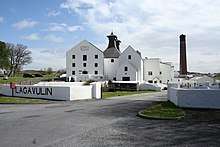
The whiskies of the distilleries along the southeastern coast of the island, Laphroaig, Lagavulin, and Ardbeg, have a smoky character derived from peat, considered a central characteristic of the Islay malts, and ascribed both to the water from which the whisky is made and to the peating levels of the barley. Many describe this as a "medicinal" flavour. They also possess notes of iodine, seaweed and salt.[8] Caol Ila, on the northern side of the island, across from Jura, also produces a strongly peated whisky. Trees, other than plantations, on these islands are scattered and the peat is free of rotting wood. (Normal peat bogs are invaded by trees and periodic fires kill the encroaching tree line.) Islay peat is reputedly the best flavoured for scotch production.

The other distilleries on the island make whisky in a variety of styles. Bunnahabhain makes much lighter whiskies which are generally lightly peated. Bowmore, which started business in 1779, produces a whisky which is well balanced, using a medium-strong peating level (25 ppm) but also using sherry-cask maturation. The Kilchoman distillery started production in late 2005; in location it is unlike the other distilleries, which are all by the sea. The newest distillery is Ardnahoe, the island's ninth, which opened in 2019.[9]

In general however, the whiskies from this island are known for a "pungent peaty, smoky and oily flavours, with just a hint of salty sea air and seaweed" because of the use of peat and the maritime climate.[2] The Island's own web site is more specific. Distilleries in the south make whisky which is "medium-bodied ... saturated with peat-smoke, brine and iodine" because they use malt that is heavy with peat as well as peaty water. Whisky from the northern area is milder because it is made using spring water for a "lighter flavoured, mossy (rather than peaty), with some seaweed, some nuts..." characteristic.[10]
In future however, the whisky industry on this island may be moving to a broader range of products, some less peaty than the current majority as well as new types of whisky.[11]
Distilleries
Active distilleries
| Distillery | Pronunciation† | Scottish Gaelic form†† | Meaning of Gaelic form | Years active | Location | Ownership |
|---|---|---|---|---|---|---|
| Ardbeg | /ɑːrdˈbɛɡ/ ard-BEG | An Àird Bheag | small promontory[12] | 1815–1981, 1990–1996, 1997– | Ardbeg village, on the south-east coast of the island | Glenmorangie Company Ltd, a subsidiary of LVMH |
| Bowmore | /boʊˈmɔːr/ boh-MOR | Bogh Mòr | the big bend[13] | 1779– | In the town of Bowmore, the island's largest settlement on the eastern shore of Loch Indaal | Morrison Bowmore Distillers Ltd, a subsidiary of Beam Suntory |
| Bruichladdich | /brʊxˈlædi/ bruukh-LAD-ee | Bruthach a' Chladaich | brae of the shore[14] | 1881–1995,‡ 2001– | Bruichladdich village, on western shore of Loch Indaal | Reopened as an independent distillery in 2001 and purchased in 2012 by Remy Cointreau[15] |
| Bunnahabhain | /ˌbuːnəˈhævən/ BOO-nə-HAV-ən | Bun na h-Abhainne | mouth of the river[16] | 1880/1883– | Bunnahabhain Bay, on the north-east coast of the island | Distell Group Limited |
| Caol Ila | /kʌlˈiːlə/ kuul-EE-lə | Caol Ìle | The Sound (Strait) of Islay[17] | 1846–1972,‡ 1974– | Close to Port Askaig, on the north-east coast of the island | Diageo |
| Kilchoman | /kɪlˈxoʊmən/ kil-KHOH-mən | Cille Chomain[18] | St. Comman's church | 2005– | Close to the village of Bruichladdich | Independently owned and established in 2005 as the first new distillery on Islay since 1881[19] |
| Lagavulin | /ˌlɑːkəˈvuːlɪn/ LAH-kə-VOO-lin | Lag a' Mhuilinn | the hollow of the mill[20] | 1742/1816– | Lagavulin village, on the south-east coast of the island | Diageo |
| Laphroaig | /ləˈfrɔɪɡ/ lə-FROYG | Laphraoig
(Believed to be Gaelicised Old Norse)[21] |
slope of broad-bay[21] | 1815– | Laphroig village, on the south-east coast of the island | Morrison Bowmore Distillers Ltd, a subsidiary of Beam Suntory |
| ‡ Except during the Great Depression (~1930–1937) and World War II (~1940–1945) | ||||||
† These reflect what are often anglicised re-spellings of Scottish Gaelic. Pronunciation of the Scottish Gaelic from which they are derived may be different.
†† The Scottish Gaelic from which the distillery's name was anglicised if applicable, according to Ainmean-Àite na h-Alba. Not necessarily an official name of the distillery.
New distilleries
Hunter Laing's Ardnahoe Distillery, located between Port Askaig and Bunnahabhain, opened in April 2019, becoming Islay's ninth distillery.[22][9]
A new distillery at Gartbreck Farm, just south of Bowmore, was planned in 2014 by Jean Donnay of Glann ar Mor Distillery[23] in Brittany, France, as a joint venture with Hunter Laing of Glasgow but as of December 2018 the project was stalled over a land and management dispute.[24] It is thought another distillery may open in Port Ellen in the future, possibly under the name of Farkin Distillery.[25]
Closed distilleries
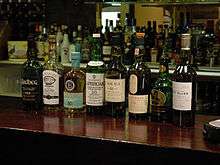
The oldest record of a legal distillery on the island of Islay refers to Bowmore in 1779 and at one time there were up to 23 distilleries in operation.[26] For example, Port Charlotte distillery operated from 1829 to 1929[27] and Port Ellen is also closed although it remains in business as a malthouse[26] that supplies many of the Islay distilleries.
In March 2007 Bruichladdich Distillery announced the reopening of the distillery at Port Charlotte (Port Sgioba in Gaelic), which was closed in 1929, and was also known as the Lochindaal distillery.
- Ardenistle (1837–1849) / Kildalton (1849–1852) / Islay (1852–1852), subsumed by Laphroaig 1853
- Ardmore (1817–1835), taken over by Lagavulin 1837
- Daill (1814–1830), ruins on road between Port Askaig & Bridgend
- Freeport (1847–1847), location unknown
- Kildalton (1817–1837), merged with Lagavulin
- Killarow (c.1760–1818) / Bridgend (1818–1822), ruins in village
- Lochindaal/Port Charlotte/Rhinns (1829–1929), near Bruichladdich
- Lossit (1821) / Ballygrant (1826–1860), ruins south of the village A846
- Malt Mill (1908–1962), now part of Lagavulin[28]
- Mulindry (1826–1827), at the junction of the Neriby Burn and the River Laggan, now in ruins[28]
- Newton (1819–1837), ruins immediately south of A846 between Port Askaig & Bridgend[28]
- Octomore (1816–1852), ruins near Port Charlotte
- Port Ellen (1825–1929, 1967–1983), large port village of Islay, converted to a malting[26][28]
- Scarabus (1817–1818), no evidence of production
- Tallant (1821–1852), Tallant farm south of Bowmore
References
- "The Scotch Whisky Regulations 2009". The National Archives. Retrieved 22 April 2012.
- WHISKY DISTILLERIES ON ISLAY
- Newton (1995) p. 32
- "Whisky Regions & Tours" Archived 26 July 2018 at the Wayback Machine. Scotch Whisky Association. Retrieved 22 April 2012.
- "Islay Malt Whisky and Islay Whisky Distilleries Map". Islayinfo.com. Retrieved 16 December 2019.
- "Islay Distilleries - Whisky Tours, Tastings & Map". VisitScotland. Retrieved 16 December 2019.
- Peat, bog and world-class whisky – why Islay remains the jewel in Scotland’s single-malt crown
- Jackson, Michael, Michael Jackson's Complete Guide To Single Malt Scotch, (Running Press Book Publishers, 2004), 48.
- "Ardnahoe Distillery on Islay officially opens". BBC. 12 April 2019. Retrieved 13 April 2019.
- Islay Malt Whisky & Islay Distilleries
- ISLAY’S TURBULENT WHISKY HISTORY
- "Ardbeg". www.ainmean-aite.scot. Retrieved 17 December 2017.
- "Bowmore". www.ainmean-aite.scot. Retrieved 17 December 2017.
- "Bruichladdich". www.ainmean-aite.scot. Retrieved 17 December 2017.
- "Remy Cointreau to buy Scotland's Bruichladdich". Wall Street Journal. Retrieved 26 July 2012.
- "Bunnahabhain". www.ainmean-aite.scot. Retrieved 17 December 2017.
- "LearnGaelic - Dictionary". learngaelic.scot. Retrieved 17 December 2017.
- "LearnGaelic - Dictionary". learngaelic.scot. Retrieved 17 December 2017.
- "Distillery History". Kilchoman Distillery. 17 April 2012. Retrieved 18 December 2017.
- "Lagavulin". www.ainmean-aite.scot. Retrieved 17 December 2017.
- "Laphroaig". www.ainmean-aite.scot. Retrieved 17 December 2017.
- "Islay Single Malt Scotch Whisky". Ardnahoe Distillery. Retrieved 16 December 2019.
- "Gartbreck Distillery". Glannarmor.com. Retrieved 16 December 2019.
- "Gartbreck distillery: is there still hope?". Scotch Whisky. Retrieved 16 December 2019.
- "Four New Whisky Distilleries on Islay - Islay Blog". Blog.islayinfo.com. Retrieved 16 December 2019.
- Newton (1995) p. 33
- "Port Charlotte Distillery". IslayInfo. Retrieved 22 April 2012.
- "Islay's "lost" Whisky Distilleries". Islayinfo.com. Retrieved 1 December 2012.
Sources
- Newton, Norman (1995) Islay. Devon. David & Charles PLC. ISBN 0-907115-90-X
